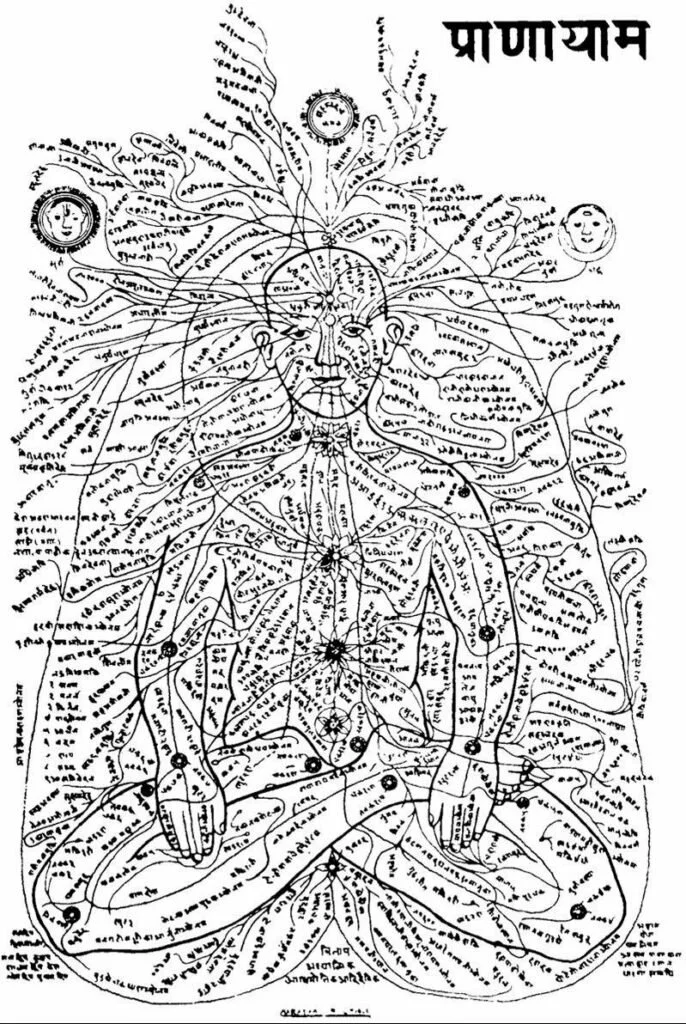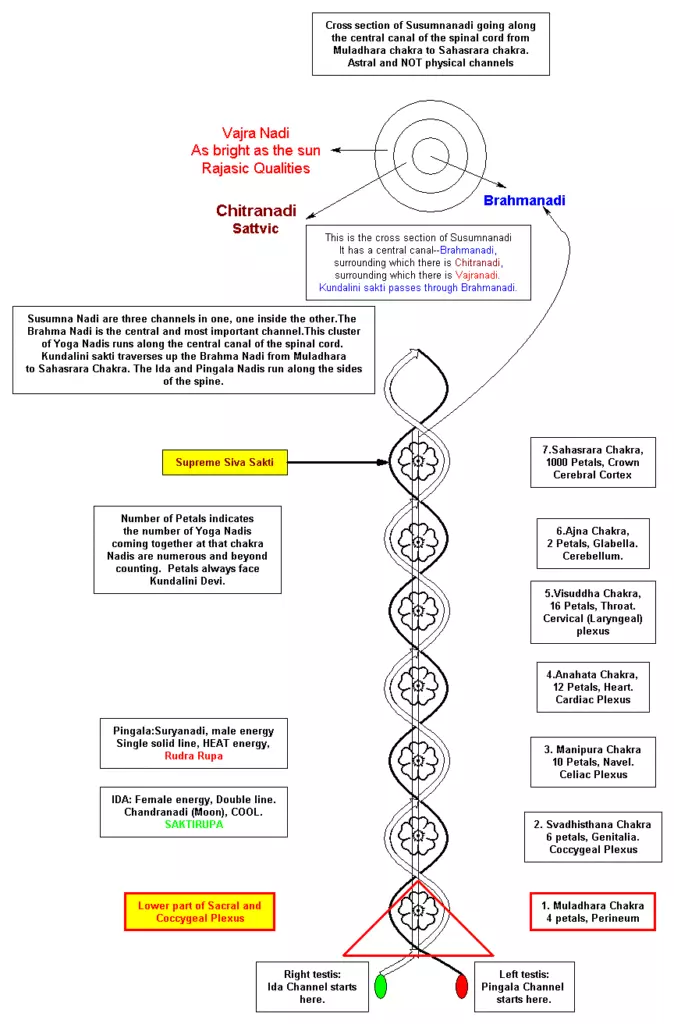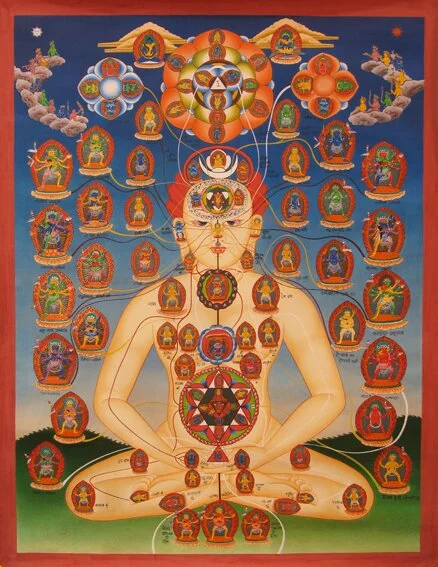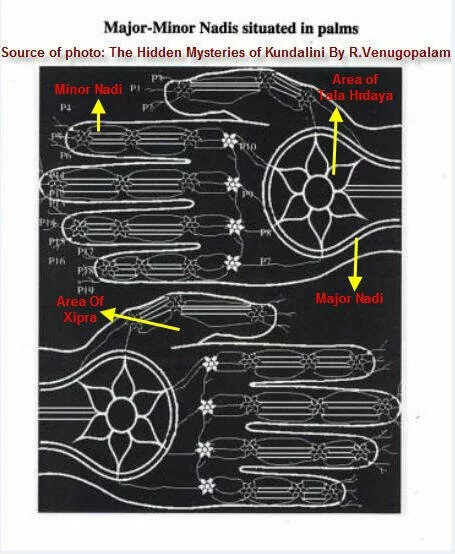Nadis are subtle cylindrical pipes that branch out from centers in the physical and astral bodies and transmit psychic currents to different areas. Through these Nadis the fundamental power of life (Prana) surges. They are composed of delicate astral substance and are undetectable. These Nadis are not the nerves or arteries that are acknowledged in the Vaidya Shastra. The physical and astral bodies have different kinds of nadis.

1. GROSS nadis, are composed by blood vessels, nerves, lymph canals, etc. 2. SUBTLE nadis which are imperceptible conduits of subtle power. These subtle nadis are divided or categorized in two types: 1. Pranavaha Nadis: Carrying Prana (vital Force) 2. Manovaha Nadis: Manas Shakti (mental Force) flows in theme. In the yoga system there are three main nadis. Ida runs by the sympathetic nerve. Pingala runs along the parasympathetic nerve and Shushumna runs in the center of the spine. As such, the Ida Nadi is associated with the artistic and restorative system of the body and the right hemisphere of the brain, it is affected by left nostril, whereas the Pingala Nadi, is associated with calculative and mathematical responses coming from the left hemisphere of the brain, which is affected by the right nostril. As each rises up the back and neck and over the head, this nadis meet in the Ajna chakra, or ‘third eye,’ and then drop down into the nose, the Ida Nadi terminating in the left nostril, and the Pingala Nadi terminating in the right nostril.
There is a virtual autonomy of these two hemispheres that is obvious and evident on a daily basis. `Split-brain’ patients, confirm that after surgery they feel completely normal. In an effort to relentlessly heal cases of epilepsy, surgeons through a delicate intervention, cut the corpus callosum, the major group of neural fibers relating the left and right hemispheres of the neocortex. The standard activities and the manifestation of `split-brain’ patients in itself, implies that the purpose of the corpus callosum is subtle. It is vital not to overestimate the separation and functions of a normal human being. The multifaceted wiring arrangement of the corpus callosum denotes if I am not wrong, that interface and communication between hemispheres is a fundamental interrelation. If you are really healthy, you will breathe predominantly through the Ida nostril for about one hour and fifty minutes, then through the Pingala nostril for equal time. Each Hemisphere has a different quality and conversely stimulates us in diverse ways, changing dramatically our moods and even affecting severely, the health of the physical body.
HERE ARE SOME EXAMPLES OF QUALITIES OF THESE TWO HEMISPHERES. Left brain: Pingala Nadi Solar and Masculine Based on reason Objective Ruling Mathematical Positive Optimistic Extroverted Vigorous Chronological Judgmental Commonsensical Academic Analytical Imaginable Recollect and remember Explanative Conversational Unambiguous Fractional Verbal Recognizes words Right brain Ida Nadi, Lunar and Feminine
Spiritual Subjective Imaginative Poetic Gloomy Unenthusiastic Reclusive Unreceptive In present moment Emotion Passion Instinct Sympathetic Analog Non-verbal Simplistic Quiet Contained Holistic
 SUSHUMNA – in the center of the spinal Column The Sushumna hypothetical speaking is chaotic for most material purposes, this is because the ego somehow is absent while the energy circulates through it, that is way all material undertakings should be avoided during its flow. However, we should take advantage of this flow and do spiritual. Sushumna could as well intensify sexual enjoyment, but the most important thing is that it could bring forth liberation. The Kundalini ascends through the Sushumna when it awakens with its tremendous force. Kundalini, awakens and evolves, its Shakti is none other than that explosive accumulated prana in movement and it is responsible for most enlightenment experiences. This pranic force rises through Pingala while the right nostril is active with fiery masculine energy in opposition Manas shakti or mental force, rises through Ida with feminine energy, while the left nostril is open and cooling energy invades the practitioner’s body. Atma Shakti (spiritual force) in the other hand rises through Sushumna (the central conduit) Here we can find a clear example of enlightenment states and how this force called Kundalini, can be the precursor of different states of consciousness and emotional upheavals; it all depends about in which channel it flows. Kundalini can either make you insane and it can also confer total freedom from the mind, which is the root of insanity. If it rises in the center of the spine and the nerves system is ready to handle the extra voltage, then certain particular states and feelings will spring from nowhere, in India they call them Samadhi, in Zen Buddhism satori and so on. Here in the Samadhi section, there is a guide and a complete description of some of them, or the most important ones, so you can compare and see if you can find any similitude, of what you are experiencing.
SUSHUMNA – in the center of the spinal Column The Sushumna hypothetical speaking is chaotic for most material purposes, this is because the ego somehow is absent while the energy circulates through it, that is way all material undertakings should be avoided during its flow. However, we should take advantage of this flow and do spiritual. Sushumna could as well intensify sexual enjoyment, but the most important thing is that it could bring forth liberation. The Kundalini ascends through the Sushumna when it awakens with its tremendous force. Kundalini, awakens and evolves, its Shakti is none other than that explosive accumulated prana in movement and it is responsible for most enlightenment experiences. This pranic force rises through Pingala while the right nostril is active with fiery masculine energy in opposition Manas shakti or mental force, rises through Ida with feminine energy, while the left nostril is open and cooling energy invades the practitioner’s body. Atma Shakti (spiritual force) in the other hand rises through Sushumna (the central conduit) Here we can find a clear example of enlightenment states and how this force called Kundalini, can be the precursor of different states of consciousness and emotional upheavals; it all depends about in which channel it flows. Kundalini can either make you insane and it can also confer total freedom from the mind, which is the root of insanity. If it rises in the center of the spine and the nerves system is ready to handle the extra voltage, then certain particular states and feelings will spring from nowhere, in India they call them Samadhi, in Zen Buddhism satori and so on. Here in the Samadhi section, there is a guide and a complete description of some of them, or the most important ones, so you can compare and see if you can find any similitude, of what you are experiencing.
Nadis and Chinese Acupuncture Channels According to a Japanese Zen master Hiroshi Motoyama, Nadis (network of channels in the human body, from Indian’s ancient literature) and Chinese acupuncture meridians are related, if we study closely some Chinese acupuncture meridians charts we can understand that these two traditions go hand by hand from time immemorial. In the Yoga-shikkha Upanishads, it is stated that the navel is the root of 72,000 nadis or channels, some flowing perpendicular and others parallel to the floor”. Chinese researchers have the same opinion; they believe that the meridian arrangement, originates at Cung-wan or CV12 acupressure point, which finds its roots above the navel. There are three KAN axis, or stomach hubs, Shan-wan below the sternum, Gekan which center is Hsia wan or CV13, above the navel, and Chu Kan or chuan wan, above Gekan. Chukan and Gekan are actually at the Manipura chakra and within its perimeter. It is feasible that if we count all Chinese, astral or energy meridians, its ramifications and the meridians at the physical level, we could actually count 72,000 also. However, there is not a common agreement concerning the number of nadis, the numbers oscillate from 72,000 to 370,000. The number 72,000 is more popular among the scriptures in India, it is said that of these 72,000, 14 are the most important ones; nevertheless, some books differ and say 10 or 12 are the important ones. This is an attractive statement, for the reason that in Chinese medicine, the most important meridians are 12, they are: lungs, large intestines, pericardium, triple burner, heart, small intestine, spleen, stomach, liver, gallbladder, kidney, and bladder Sushumna Nadi
It is in the center of the spine, which is responsible for most of the enlightenment experiences, Shandilya Upanishads state that Sushumna is the most important Nadi. This Nadi finds its roots at the Muladhara Chakra, in the perineum and ends at the crown of the head, the Sahasrara Chakra, this view, however, is contradicted by Chhandogya Upanishads which affirms, that Sushumna begins at the heart, this view is actually backed by a great saint experience in India (Ramana Maharshi) who also thought his kundalini energy was rising at this point. Chinese medical understanding, points out that in this identical place, exists an extraordinary meridian, identified as the governor chanel, which initiates at the coccyx, crosses the center of the spinal column, strikes the crown of the head and concludes its route in the center of the upper lip, here you can note the similarity to the Sushumnas pathway, described by Shandilya Upanishads. It is believed that a huge amount of CHI, is accumulated in this meridian, like water in a thunderous ocean. Ida and Pingala

Sri shabhala Darshana Upanishads estates that these two nadis are parallel to the Muladhara chakra and pierce the Brahma knot within it, the ida is located to the left and Pingala to the right, and they originate, I presume at Muladhara also, but its foundation is not obvious in this book, on the other hand, the yoga shikka Upanishads tells us, that Ida and Pingala are born at the navel, rather than the Muladhara, but at the same time it agrees that they lay on each side of the spine. Shandilya and Sri Jabala Darshana Upanishads said that they terminate in the nostrils, but it is not clear if they intersect Muladhara in a crisscrossing manner.
In my opinion, Kundalini rises in a crisscrossing manner and it touches and unites Ida, Pingala, and Sushumna, my theory will leave us with the understanding that Ida and Pingala ascend straight up just as the second lines of the urinary bladder meridian. Motoyama says that in traditional Chinese medicine “these meridians originate at the bridge of the nose, flow up over the head, enter inside it, and merge at the back of the head, then they divide in two branches, one line called the third, that courses down the back, 9 cm from the spine, passes along the back of the leg, and terminates on the fifth toe; the second line passes down the back about 4.5 cm from the spine going from the lumbar region to the urinary bladder itself. The first line of the urinary bladder meridian, lays 1 cm at both sides of the spine, right and left just as Ida and Pingala” Gandhari Nadi The Gandhari Nadi hides behind the Ida Nadi and terminates in the left eye, one out of 11 ancient Indian books; the Siddhasiddhatapaddhati to be more precise argues that it ends in the ears. These descriptions leave us thinking according to Motoyama, that Gandhari may correspond to the third line of the urinary meridian. On the left side of the body, the first line of the urinary Chanel lines is located approximately 1 cm on either side of the spine, the second and third lines about 4 cm and 9 cm away, these three lines run parallel to the spine in direction to the buttocks. Hastijiva Nadi.
Shri Jabala Darshana Upanishad tells us that this Nadi, lies also behind the Ida Nadi, and terminates at the tip of the big toe, other books said that it ends at the right ear or eye, these discrepancies leave us wondering, and with the idea that it may correlate to the liver and spleen meridian which also terminates at the big toe, but if we grab an acupuncture chart, then we can also understand that they flow along the front of the body, therefore it can’t correspond to these nadis, so we have no other option that to compare it with the urinary bladder Chanel, which in Chinese acupuncture is the only one running along the spine. Motoyama believes as well that if we follow the other theory that this Nadi finishes its route at the eyes, then we can identify this Nadi with the bladder acupuncture meridian that also ends here, but it’s difficult to know exactly to which of the three branches it really correlates with. Shri Jabala Darshana Upanishad, locates Gandhari and Hastijihva lateral to the ida, presumably on the left side, with the pusha and yashasvini Nadi, concurrently situated in relation to the Pingala on the right, furthermore, the Hastijihva and yashasvini are both described as terminating in the left big toe, on the other hand, the terminal points of the pusha and Gandhari are not mention, consequently it may be incidental that these two latter groups, form complementary left-right pairs.

The Yashasvini Nadi This Nadi lies on one side of Pingala, between pusha, which is behind Pingala, goes up reaching the right eye. Saraswati is to the side of Sushumna, it is not specified on which side, but we can assume that it is to the right because it’s said that the Shankhini position is between Saraswati and Gandhari, on the left of Sushumna, so Saraswati must be on the left. Then again this Nadi matches up with one of the branches of the urinary bladder meridian. According to Motoyama, On the left is Hastijihva, which forms a pair with yashasvini correlating to the first line of the Bladder Meridian and the Gandhari paired with Pusha is the third branch of the bladder meridian. Here you can note discrepancies, with my theory about IDA and PNGALA, which I had correlated with the first branch of the bladder meridian. The spleen and liver are the only channels that connect to the big toe, simultaneously, the terminal point of Hastijihva and yashasvini nadis according to Shri Jabala Darshana Upanishad are also ending in the big toe; however they do not run along the back as the spleen and liver meridians, on the other hand, the Bladder meridian terminates in the small toe. We have to understand that we are facing a general lack of detail considering the nadi’s path in most of the Indian books, and I am inclined to believe that most of these ancient texts were probably destroy by time’s tyrant hands, so it is very difficult to actually locate the flow of this Nadis throughout the physical body, and I feel that it is not unreasonable to match this Nadi again to one of the branches of the bladder meridian. Alambusa Nadi. Shri Jabala Darshana Upanishad brings into light the understanding that this Nadi runs from the anus to Kandasthana, which is in the periphery of Manipura chakra. Shandilya Upanishad tells us that it flies up to the tonsils, on the other hand, Gorakshashatakam and Yoga Cudamani Upanishad, claim that it terminates in the mouth, while yoga-shikka Upanishad in opposition believes that it continues to the ear. Motoyama tells us that, In Chinese acupuncture of the fourteen major meridians, only the conception meridian starts in the anal area and runs along the anterior meridian line to the mouth. In yoga theory, Sushumna, Ida, and Pingala are considered the main and most important nadis, nevertheless, in Chinese medicine, the conception vessel meridian is of major importance as it is the central connecting chanel for the ying meridians. Kahu Nadi
Shri Jabala and Shandilya Upanishad hypothetical understanding implies that this Nadi has a bow-shaped area, that is located between Sushumna and Raka near the pharynx, it runs downwards along the lines of Sushumna and then up, ending at the nose tip, it seems that this Nadi runs in front of Sushumna; in disagreement the Shandilya Upanishad declares that Kahu Nadi ends in the genitals.Motoyama declares that the acupuncture meridian that is located on the front of the body, which finishes in the genital area is the liver meridian, it starts at the tip of the big toe, runs up the medial side of the leg into the genital area, follows a curved, bow shape path to the side of the anterior median line and then reaches the top of the head, passing throughout the throat and eyes. if we compare correctly then we can be convinced, that the Kahu Nadi corresponds to the liver meridian, and the path along the leg was omitted or lost throughout the years. You can note also that there is not much said, in any of these books about the paths of the meridians throughout the extremities. Shankhini Nadi The pivotal point is in the throat, which is connected to Muladhara chakra, anus and penis, ending in the ears. This is pretty much the same path than the kidney’s meridian path, which starts at the tip of the little toe, passes up the medial side of the leg, through the pubic area, and then goes up on one side of the median line of the body, up to the throat ending at the root of the tongue. A second line connects the kidney to the main meridian line in the pubic region. In Chinese medicine, kidney disorders are associated with ear disorders, and vice-versa, this explains the relationship of these two. Saraswati Nadi
 This Nadi goes up on one side, (we believe it’s the right side) and terminates in the tongue, if this Nadi lies in front of Sushumna as stated in some books, then we can at once say that this is the spleen meridian, the spleen meridian starts at the big toe, goes up the leg, enters the abdomen, then circulates in the spleen in an spiral manner, it then penetrates the diaphragm, rises through the chest and throat, and it concludes at the root of the tongue. Varuni Nadi One source states that Varuni is in between Yashasvini and Kahu, pervading all areas above and below Kundalini. Another text says that it flows down the navel to promote excretion. In either case it seems to be related to the lower abdomen functions. Yoga-shikka Upanishads claims that Varuni Nadi infuses energy to the large intestine, colon, rectum, and anus. According to Motoyama, Varuni may be just a gross physical Nadi; they must be referring to the intestines, as they are a viaduct. Some ayurveda scriptures, call nadis the ducts of the urethra, and some uterine tubes as the fallopian tromps. According to these and other descriptions in different books, we can assess that, gross nadis are any kind of cylindrical conduits, like veins, arteries, nerves, intestines and any other orifices and tubes like channels in the physical and astral body. Payasvini Nadi. According to Shandilya Upanishad this Nadi runs between Pusha and Saraswati, if the Pusha corresponds to the third line of the urinary bladder meridian on the right side, and if the Saraswati correlates to the spleen meridian in the front of the body, this Nadi should be associated to the right branch of the gall bladder meridian. Shri Jabala Darshana Upanishad indicates that this Nadi terminates at the edge of the right ear, here it resembles the gallbladder meridian passing point, which is also the ear. The gallbladder meridian starts in the outer corner of the eye, travels across the side of the skull, above the ear, then around it, then it passes through the neck, runs downwards in a Zigzag motion along the side of the trunk, the lumbar area and finally the outside of the leg, terminating at the forth toe. Shura Nadi.
This Nadi goes up on one side, (we believe it’s the right side) and terminates in the tongue, if this Nadi lies in front of Sushumna as stated in some books, then we can at once say that this is the spleen meridian, the spleen meridian starts at the big toe, goes up the leg, enters the abdomen, then circulates in the spleen in an spiral manner, it then penetrates the diaphragm, rises through the chest and throat, and it concludes at the root of the tongue. Varuni Nadi One source states that Varuni is in between Yashasvini and Kahu, pervading all areas above and below Kundalini. Another text says that it flows down the navel to promote excretion. In either case it seems to be related to the lower abdomen functions. Yoga-shikka Upanishads claims that Varuni Nadi infuses energy to the large intestine, colon, rectum, and anus. According to Motoyama, Varuni may be just a gross physical Nadi; they must be referring to the intestines, as they are a viaduct. Some ayurveda scriptures, call nadis the ducts of the urethra, and some uterine tubes as the fallopian tromps. According to these and other descriptions in different books, we can assess that, gross nadis are any kind of cylindrical conduits, like veins, arteries, nerves, intestines and any other orifices and tubes like channels in the physical and astral body. Payasvini Nadi. According to Shandilya Upanishad this Nadi runs between Pusha and Saraswati, if the Pusha corresponds to the third line of the urinary bladder meridian on the right side, and if the Saraswati correlates to the spleen meridian in the front of the body, this Nadi should be associated to the right branch of the gall bladder meridian. Shri Jabala Darshana Upanishad indicates that this Nadi terminates at the edge of the right ear, here it resembles the gallbladder meridian passing point, which is also the ear. The gallbladder meridian starts in the outer corner of the eye, travels across the side of the skull, above the ear, then around it, then it passes through the neck, runs downwards in a Zigzag motion along the side of the trunk, the lumbar area and finally the outside of the leg, terminating at the forth toe. Shura Nadi.
This Nadi is mentioned only in the yoga-shikka Upanishad. This succinct description says that it runs from the navel up to the midpoint between the eyebrows, here at this point lays the governor vessel meridian, however this Chinese meridian corresponds more to Sushumna Nadi, therefore it is extremely difficult to pair this Indian Nadi to a Chinese acupuncture meridian. It could be an unknown ramification of the governor vessel meridian. Visvodari Nadi The Visvodari runs between the Kahu (corresponding to the liver meridian) and the Hastijihva (the first line of the urinary bladder on the left side) Motoyama states that among the acupuncture meridians that run through the horizontal cross-section of the body at the hip level, are the second and third line of the urinary bladder meridian as well as the gall bladder, spleen, kidney, and stomach; these ones are found between the liver meridian and first line of the urinary bladder meridian, so here it is again extremely difficult to locate the position of this Nadi. The Shri Jabala Darshana Upanishad says that Visvodari resides inside Kandasthana and Yoga Shikka Upanishad notes that it receives four kinds of nourishment, since Kandasthana is the area that encloses Manipura, the third chakra at the navel, then we can get closer to believe that this Nadi is related to the stomach meridian. Citrini Citrini is the thin Nadi in the center of Sushumna. There is no correlation whatsoever that we can make, to any of the Chinese meridians.
